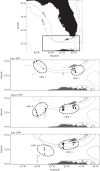Close encounters with eddies: oceanographic features increase growth of larval reef fishes during their journey to the reef
- PMID: 25631227
- PMCID: PMC4321146
- DOI: 10.1098/rsbl.2014.0746
Close encounters with eddies: oceanographic features increase growth of larval reef fishes during their journey to the reef
Abstract
Like most benthic marine organisms, coral reef fishes produce larvae that traverse open ocean waters before settling and metamorphosing into juveniles. Where larvae are transported and how they survive is a central question in marine and fisheries ecology. While there is increasing success in modelling potential larval trajectories, our knowledge of the physical and biological processes contributing to larval survivorship during dispersal remains relatively poor. Mesoscale eddies (MEs) are ubiquitous throughout the world's oceans and their propagation is often accompanied by upwelling and increased productivity. Enhanced production suggests that eddies may serve as important habitat for the larval stages of marine organisms, yet there is a lack of empirical data on the growth rates of larvae associated with these eddies. During three cruises in the Straits of Florida, we sampled larval fishes inside and outside five cyclonic MEs. Otolith microstructure analysis revealed that four of five species of reef fish examined had consistently faster growth inside these eddies. Because increased larval growth often leads to higher survivorship, larvae that encounter MEs during transit are more likely to contribute to reef populations. Successful dispersal in oligotrophic waters may rely on larval encounter with such oceanographic features.
Keywords: larval dispersal; larval fish growth; mesoscale eddies; otolith microstructure; population replenishment; reef fish.
© 2015 The Author(s) Published by the Royal Society. All rights reserved.
Figures


References
-
- Werner FE, Cowen RK, Paris CB. 2007. Coupled biological and physical models. Oceanography 20, 54–69. (10.5670/oceanog.2007.29) - DOI
-
- Kristiansen T, Vikebo F, Sundby S, Huse G, Fiksen O. 2009. Modeling growth of larval cod (Gadus morhua) in large-scale seasonal and latitudinal environmental gradients. Deep-Sea Res. II 56, 2001–2011. (10.1016/j.dsr2.2008.11.011) - DOI
-
- Sponaugle S, Pinkard DR. 2004. Impact of variable pelagic environments on natural larval growth and recruitment of the reef fish Thalassoma bifasciatum. J. Fish Bio. 64, 34–54. (10.1111/j.1095-8649.2004.00279.x) - DOI
-
- McGillicuddy DJ, Robinson AR, Siegel DA, Jannasch HW, Johnson R, Dickey TD, McNeil J, Michaels AF, Knap AH. 1998. Influence of mesoscale eddies on new production in the Sargasso Sea. Nature 394, 263–266. (10.1038/28367) - DOI
-
- Lane PVZ, Smith SL, Graber HC, Hitchcock GL. 2003. Mesoscale circulation and the surface distribution of copepods near the south Florida Keys. Bull. Mar. Sci. 72, 1–18.
Publication types
MeSH terms
LinkOut - more resources
Full Text Sources
Other Literature Sources
Molecular Biology Databases
Miscellaneous

